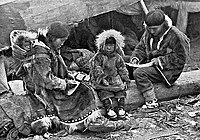
Photo from wikipedia
After more than four decades of research and almost 100 attachment studies, the mechanisms of intergenerational transmission of attachment still remain unclear. To better understand the mechanisms moderating the associations… Click to show full abstract
After more than four decades of research and almost 100 attachment studies, the mechanisms of intergenerational transmission of attachment still remain unclear. To better understand the mechanisms moderating the associations of attachment orientations from one generation to the next, this empirical study examined the roles of 1) shared and non-shared environmental factors that characterize critical events in adulthood such as career choice, income and child care; 2) gender differences in attachment between parents (Generation 1, G1) and their adult offspring (Generation 2, G2) and their possible interactions. A sample of 321 families with G2 adults aged 18 and over and two G1 parents up to the age of 81 took part in this study. Both generations completed the Experiences in Close Relationships attachment measure as well as a comprehensive detailed measure of current core characteristics in adulthood (e.g. employment status, income, whether they had children) and demographic variables (gender, age). The findings suggest that the associations between the attachment orientations of G1 and the attachment orientations of G2 were moderated by G2’s income, their G1 paternal income and employment status, whether G2 had children (G3) of their own, and their family status after controlling for the age of G2, and the age of both paternal and maternal G1. When the associations for both paternal and maternal G1attachment orientation with both their male and female G2 was analyzed separately, this accounted for 35% of the variance of males’ G2 attachment orientation. The discussion focuses on the contribution of these findings to attachment theory and draws clinical conclusions.
Journal Title: PLoS ONE
Year Published: 2020
Link to full text (if available)
Share on Social Media: Sign Up to like & get
recommendations!